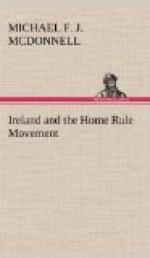That strange accusation of Sir Horace Plunkett, that “the clergy are taking the joy—the innocent joy—from the social side of the home life,” was, I think, sufficiently answered by the apposite reply of M. Paul-Dubois, that this is a strange reproach in the mouth of a Protestant who has undergone the experience of spending a Sunday in Belfast. The truth is that attacks on the Irish priesthood came ill from Englishmen or Anglo-Irishmen who have found in the Catholic Church the most powerful agent of social peace in the country. That Irishmen have on this ground any reason to blame the priesthood for lack of patriotism I as strongly deny, for though one may not think necessarily that God is on the side of the big battalions, armed resistance, which from the nature of things must be borne down by sheer force of weight, is as insensate as it is destructive.
The figure of Father O’Flynn, drawn by the son of a bishop of the Protestant Church, professes to be as much a picture of a type as the French cure whom Mr. Austin Dobson has so gracefully depicted, and it is difficult to see how such a figure of genial kindliness could have been portrayed in such a quarter or have received such general acceptance if there were to be found in any number worth considering the hard and worldly beggars on horseback whom their enemies allege constitute the characteristic type of the Irish clergy.
If in the religious nature of the Irish people is to be found one reason for the influence of the clergy in secular matters, a far more potent factor is to be seen in the historical fact that the priest has for centuries been the only guide, counsellor, and friend of the Irish peasant. The absence of a well-educated middle class, which, failing a sympathetic aristocracy, would, in a normal condition of things, provide popular leaders, is the only thing which has maintained any such undue predominance on the part of the clergy in secular affairs as exists. With the development of an educated Catholic laity, among some members of which one may expect to see evolved that critical acumen and balanced judgment which are what the fine flower of a university culture is supposed to produce, this preponderance will disappear, but in the meanwhile, be it noted, it is the refusal of Englishmen to found an acceptable university which is maintaining the very state of affairs in this direction against which they protest.




